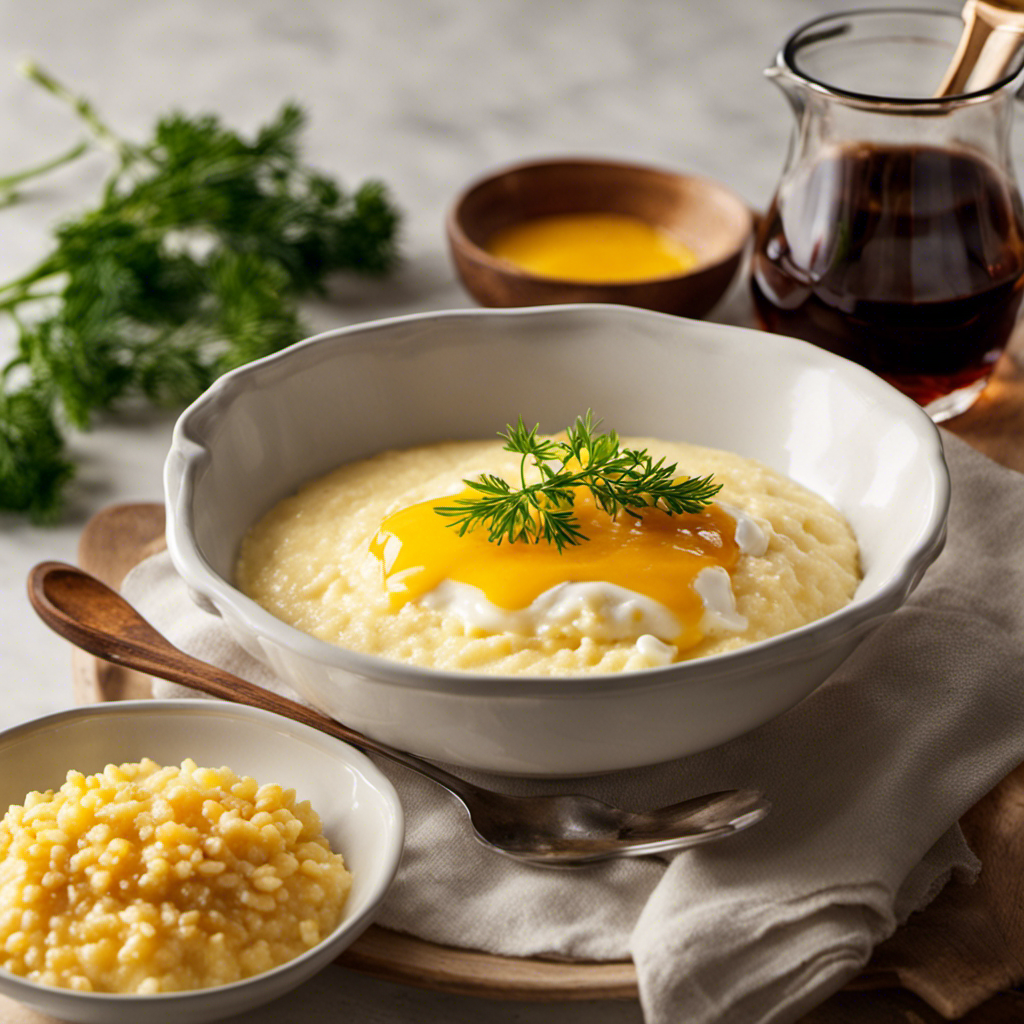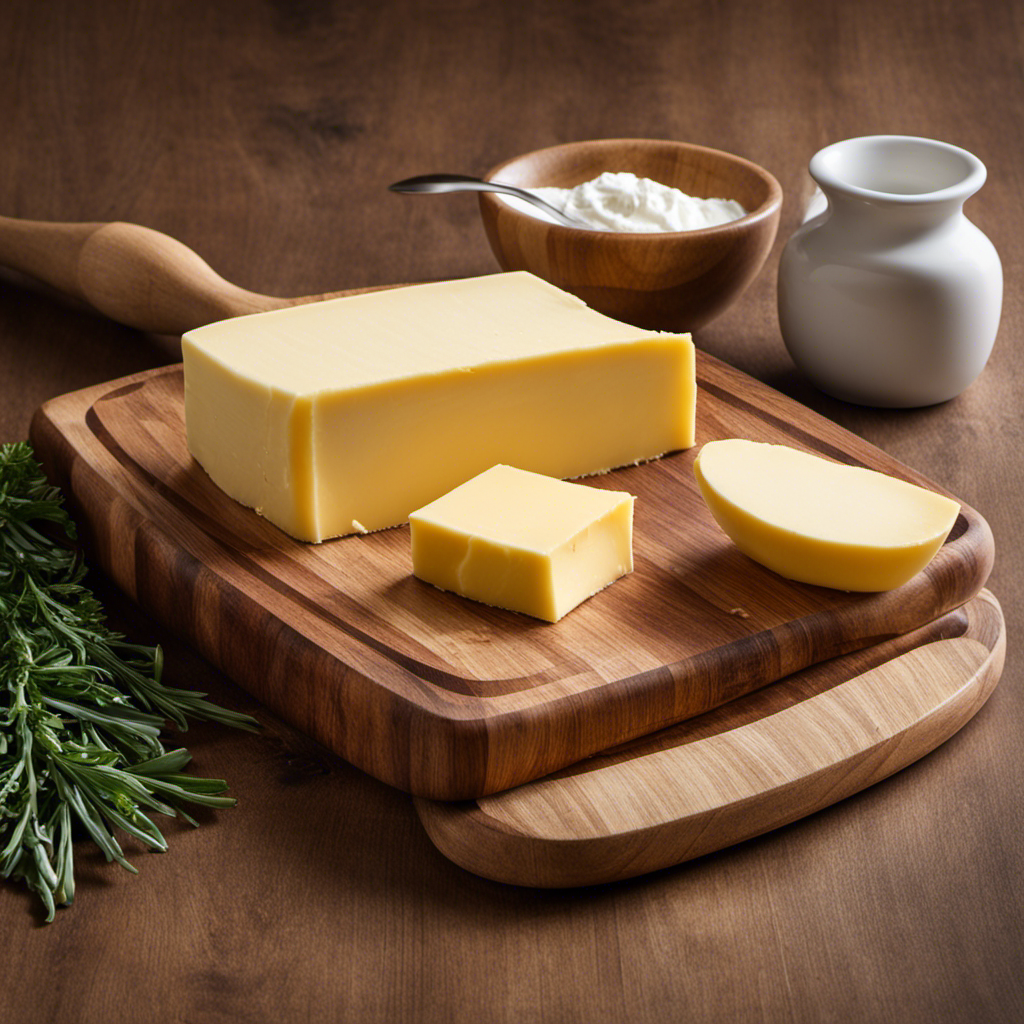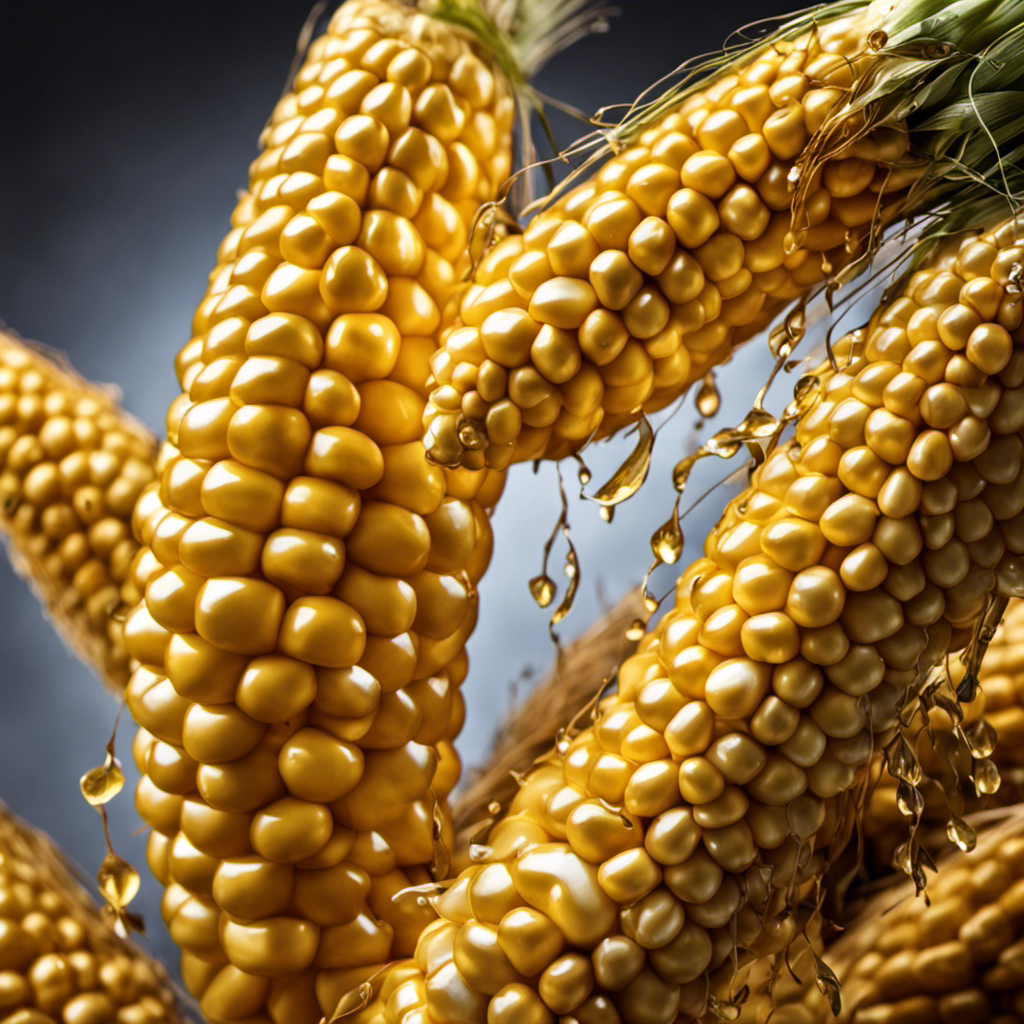I have to confess, I really enjoy grits with butter. But have you ever thought about how many carbs are in that creamy deliciousness? Well, you’re in luck because I have all the details for you.
In this article, we’re gonna dive into the health benefits of grits with butter, the nutritional value, and of course, the carb content. So grab a fork and get ready to dig in, because we’re about to break down just how many carbs are in your favorite breakfast treat.
Key Takeaways
- Butter provides essential fatty acids like omega-3 and omega-6 for brain function and reducing inflammation.
- Grits and butter offer a good balance of carbohydrates and fats, making it a satisfying and energy-rich meal.
- Moderate consumption of grits with butter can contribute to weight management and promote satiety.
- Excessive butter consumption can lead to increased cholesterol levels and health risks.
Health Benefits of Grits With Butter
There’s no denying the health benefits of grits with butter. While some may argue that butter adds unnecessary fat and calories to the dish, research suggests that moderate consumption of butter can actually have positive effects on our health.
Butter is a source of essential fatty acids, such as omega-3 and omega-6, which are important for brain function and reducing inflammation in the body. Additionally, the combination of grits and butter provides a good balance of carbohydrates and fats, making it a satisfying and energy-rich meal.
When consumed in moderation as part of a balanced diet, grits with butter can contribute to weight management by providing sustained energy and promoting satiety. However, it is important to note that excessive consumption of butter can lead to health risks, such as increased cholesterol levels, so it’s best to enjoy grits with butter in moderation.
Nutritional Value of Grits With Butter
When it comes to the nutritional value of grits with butter, there are a few key factors to consider.
Firstly, let’s talk about the carbs in grits. Grits are primarily made from corn, which means they contain a significant amount of carbohydrates.
Secondly, the impact of butter on the nutritional value of grits should be taken into account. While butter does add flavor and richness to grits, it also adds calories and saturated fat.
Lastly, we need to assess the overall healthiness of grits. While they can be a good source of energy and provide some essential nutrients, the high carb content and potential for excess butter consumption should be considered when evaluating their healthiness.
Carbs in Grits
The carb count in grits with butter is relatively high. Grits are made from ground corn, which is a starchy carbohydrate. A 1-cup serving of cooked grits contains about 31 grams of carbs. Carbohydrates are a primary source of energy for our bodies, but it’s important to be mindful of our carb intake, especially if we are watching our blood sugar levels.
The glycemic index (GI) is a measure of how quickly a food raises blood sugar levels. Grits have a high GI, meaning they can cause a rapid increase in blood sugar. This is why it’s important to monitor portion sizes and pair grits with other foods that have a lower GI to help stabilize blood sugar levels.
Now, let’s explore the nutritional impact of butter on this dish.
Butter’s Nutritional Impact
Butter adds flavor and richness to grits, but it also contributes to the dish’s overall calorie and fat content. While it enhances the taste, it’s important to consider the health risks associated with consuming too much butter.
According to dietary guidelines, excessive saturated fat intake can increase the risk of heart disease. Butter is high in saturated fat, which can raise cholesterol levels and contribute to artery clogging. It’s recommended to limit saturated fat intake to less than 10% of daily calories.
Instead of using butter, you can opt for healthier alternatives like olive oil or avocado, which contain unsaturated fats that are beneficial for heart health. Being mindful of your butter consumption can help you maintain a healthy diet and minimize the risks associated with high saturated fat intake.
Healthiness of Grits?
Grits can be a healthy option if prepared without excessive butter and paired with nutritious ingredients. While they are a carbohydrate-rich food, they can still be included in a balanced diet, especially for individuals looking to manage their weight. Here are some factors to consider when incorporating grits into a healthy eating plan:
-
Portion control: Moderation is key when it comes to consuming grits. Stick to recommended serving sizes to avoid excessive calorie intake.
-
Nutrient density: Enhance the nutritional value of grits by adding protein-rich toppings like lean meats or eggs, and incorporating vegetables for added fiber and vitamins.
-
Limiting added fats: Avoid excessive butter or fatty toppings, as they can contribute to weight gain and increase the risk of health issues.
-
Balanced meals: Make sure to pair grits with other nutrient-dense foods to create a well-rounded meal that supports overall health and weight management.
Carb Content in Grits With Butter
When considering the nutritional value of grits with butter, it is important to understand the carb contribution from the butter.
While grits themselves are a carbohydrate-rich food, the addition of butter can significantly increase the overall carb content.
It is worth comparing different variations of grits to determine the impact of butter on carb intake and consider the health implications of consuming high levels of carbohydrates.
Butter’s Carb Contribution
To accurately determine the carb contribution, you should consider the amount of butter you add to your grits. While grits themselves are a relatively low-carb food, the addition of butter can significantly increase the overall carb content. It’s important to be mindful of this, especially if you’re watching your carb intake for health or weight management reasons.
Here are some key points to consider:
- Butter is high in fat and calories, which can contribute to weight gain if consumed in excess.
- Excessive intake of saturated fats found in butter can increase the risk of heart disease.
- Adding butter to grits can make them more flavorful and satisfying, but it’s important to control the portion size to avoid excessive calorie and carb intake.
- If you’re looking to reduce your carb intake, consider using a healthier alternative to butter, such as olive oil or avocado.
Transitioning into the subsequent section about ‘comparing grits variations,’ let’s explore how different types of grits can impact your overall carb consumption.
Comparing Grits Variations
When comparing different varieties of grits, it’s important to consider their impact on your overall carb consumption. Grits are a popular Southern dish made from ground corn kernels. They come in different forms such as stone-ground, quick, and instant grits. Each variation has its own unique taste and cooking method. Stone-ground grits are known for their rich and creamy texture, but they take longer to cook. Quick grits are finer in texture and take less time to prepare. Instant grits are the most convenient option as they can be prepared in a matter of minutes. However, they may lack the same depth of flavor as stone-ground grits. Ultimately, the choice between grits variations depends on personal preference and time constraints.
| Grits Variation | Taste | Cooking Method |
|---|---|---|
| Stone-ground | Rich and creamy | Longer cooking time |
| Quick | Finer texture | Shorter cooking time |
| Instant | Convenient | Quick and easy |
(Source: Southern Living)
Health Implications of Carbs
If you’re watching your carb intake, it’s important to be mindful of the variations of grits you choose. While grits can be a delicious and filling breakfast option, they can also pose some health risks if consumed in excess. Here are some key points to consider when it comes to carb counting and the health implications of grits:
-
Carbohydrate content: Grits are primarily made from corn, which is a high-carb grain. The exact carb count will depend on the brand and preparation method, but on average, a 1-cup serving of cooked grits contains around 30-40 grams of carbs.
-
Fiber content: Grits are generally low in fiber, which means they may cause a rapid rise in blood sugar levels. Adding fiber-rich toppings like vegetables or beans can help mitigate this effect.
-
Portion control: Pay attention to your portion sizes when consuming grits. It’s easy to overeat and exceed your carb limits if you’re not careful.
-
Nutritional balance: While grits can be a part of a healthy diet, it’s important to balance them with other nutrient-rich foods to ensure you’re getting a wide range of vitamins, minerals, and macronutrients.
Impact of Grits With Butter on Blood Sugar Levels
Eating grits with butter can raise your blood sugar levels. This can have an impact on weight management and pose potential risks of high blood sugar levels. Grits, a popular Southern dish made from ground corn, are naturally high in carbohydrates. When combined with butter, which contains fats, the glycemic index of the meal increases, leading to a quicker rise in blood sugar levels. This spike in blood sugar can be particularly concerning for individuals with diabetes or those at risk of developing the condition. It is important to be mindful of portion sizes and to balance meals with other nutrient-dense foods to minimize the impact on blood sugar levels.
Here is a table showing the approximate carbohydrate content of a serving of grits with butter:
| Food Item | Carbohydrates (g) |
|---|---|
| Grits (1 cup) | 31 |
| Butter (1 tbsp) | 0 |
| Total | 31 |
Grits With Butter as a Source of Energy
Combining grits with butter provides a source of energy due to their carbohydrate and fat content. Grits are a popular Southern dish made from ground corn, and when paired with butter, they create a delicious and satisfying meal.
Here are some reasons why grits with butter can be a great source of energy:
-
Carbohydrates: Grits are rich in carbohydrates, which are the body’s main source of fuel. They provide the energy needed for daily activities and physical exercise.
-
Fats: Butter adds a creamy and flavorful touch to grits. It contains healthy fats that provide long-lasting energy and aid in the absorption of fat-soluble vitamins.
-
Satiety: Grits with butter can keep you full for longer periods, preventing excessive snacking and providing sustained energy throughout the day.
-
Versatility: Grits can be enjoyed in various recipes, such as shrimp and grits or cheesy grits. Additionally, alternative toppings like cheese, bacon, or even vegetables can be added to enhance the flavor and nutritional value of the dish.
Incorporating Grits With Butter Into a Balanced Diet
Incorporating grits with butter into a balanced diet can provide a satisfying and versatile option for long-lasting energy.
Grits are a popular Southern dish made from ground corn. When combined with butter, they become a delicious and nutritious meal. Grits are low in fat and cholesterol and provide essential nutrients like iron, thiamine, and folate. They are also a good source of complex carbohydrates, which are important for sustained energy.
One cup of cooked grits with butter contains approximately 28 grams of carbohydrates. While this may seem high, it is important to remember that carbohydrates are an essential part of a balanced diet, providing energy and fuel for our bodies.
Frequently Asked Questions
Can I Eat Grits With Butter if I Am Following a Low-Carb Diet?
Yes, I can eat grits with butter if I’m following a low-carb diet, but it’s important to be mindful of the carb content. There are healthier alternatives to butter, and other breakfast options with lower carb content.
Are There Any Potential Side Effects of Consuming Grits With Butter?
There could be potential risks and health concerns associated with consuming grits with butter. It’s important to consider the impact on your overall carbohydrate intake and how it aligns with your specific dietary goals.
How Does the Carb Content in Grits With Butter Compare to Other Breakfast Options?
Comparing carb content, grits with butter have more carbs than oatmeal. However, you can explore different toppings like cheese or avocado to add flavor and healthy fats while reducing the overall carb intake.
Can Grits With Butter Be a Suitable Option for Individuals With Diabetes?
Grits with butter can be a suitable option for individuals with diabetes. However, it’s important to consider the impact of butter on blood sugar levels. Moderation and monitoring are key.
Are There Any Alternatives to Butter That Can Be Paired With Grits for a Healthier Option?
There are healthier alternatives to butter that can be paired with grits, such as avocado or Greek yogurt. These low carb grits toppings provide a nutritious option while still adding flavor.
Conclusion
In conclusion, while grits with butter may not be the healthiest choice, they can still be enjoyed in moderation as part of a balanced diet. They provide a good source of energy due to their high carb content.
However, it’s important to be mindful of portion sizes and the impact on blood sugar levels. Incorporating grits with butter into your meals can add flavor and satisfaction, but remember to prioritize nutrient-rich foods for optimal health.
So go ahead, indulge in a warm bowl of buttery grits and experience the comforting goodness like never before!









